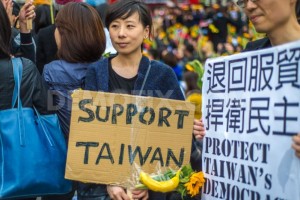The process of democratisation is for Taiwan closely related to the birth of a Taiwanese identity (Geldenhuys, 2009). After the official ending of Japanese occupation in 1952, when Japan formally renounced all its territorial rights on the island, and the strained and often volatile relationship with mainland China, the decades following the dismantling of martial law in 1987 can be considered a crucial period in the process of construction of a Taiwanese identity. The gradual deconstruction of an authoritarian regime as represented by the unconditional power of Kuonmintang and the construction of a historically new democratic system have been seen as the first steps toward an unprecedented Taiwanese national identity. Empowered by the existence of civil society and popular movements, the democratisation process has over time and in different ways reshaped cross-Straits relations creating a collective awareness of being politically differentiated from mainland China. According to Benedict Anderson, who defines nation as an imagined political community, a nation exists when ‘in the minds of each lives the image of their communion’ (Anderson, 2006). Thus, the process of democratisation of Taiwan can be considered as crucially involved in the creation of a common ‘image’, a self representation able to define a new identity.
Beginning in 1987, the process of democratisation in Taiwan saw the gradual shift from authoritarianism to democratic rule and contributed in part to dismantling the complex structure of the Chinese identity that had been deeply embedded in the Taiwanese consciousness (Rou-Lan Chen, 2014). As a consequence, the preservation of democracy is a focal point for the modern perception of Taiwanese national identity. Yet the passing of the controversial Cross-Strait Service Trade Agreement (CSSTA) by the Kuomintang and the irregular management of the reviewing process illustrate problems in Taiwan’s democracy, causing an outburst of Taiwanese student-led protests – also known as the “Sunflower Movement” – that peaked with the occupation of the Legislative Yuan between March and April 2014. The wave of demonstrations and the nature of the activists’ claims, that met with a strong reaction from the ruling party, seem to be based on widespread dissatisfaction among the Taiwanese population.
The discontent is partly due to the obscurity of the Cross Strait Service Trade Agreement and its potential implications for Chinese-Taiwanese relations, but the growing polarization of party politics, expanding social inequality, and ineffective representative democracy also have contributed to social unrest. Although it is too early to establish on the political level the long-term implications of the Sunflower Movement, it has gained some significant successes worth analysing. First of all, it brought together different parts of Taiwanese society, including at least fifty-four NGOs and civic organisations . Second, the movement represents an explicit opposition to Beijing’s old formula ‘one country, two systems’ , thus reinforcing the idea of a separate Taiwanese national identity. Third, as noted above, Taiwan’s transition to democracy over the last twenty years has been of crucial importance for the country’s construction of a new national identity as being distinguished from that of the Chinese one. Indeed, the current mutual accusations between the Taiwanese government and the participants in the Sunflower Movement of being anti-democratic stresses the fundamental role of the discourse of democracy for Taiwan, its civil society, and a democratic Taiwanese identity that is different from the non-democratic Chinese identity. This also might explain why the Sunflower Movement seems to be calling for a second wave of democratisation in emphasising widespread social frustration and problems of democracy, of which the CSSTA itself as well as its management by party rule are one of the highest expressions. Overall, the emergence of the Sunflower Movement seems to indicate that the CSSTA will exert an influence not only on the economic relationship between Taiwan and mainland China, but also on the political relations between Taipei and Beijing, thus affecting the nature of Taiwanese national identity.
Article written by Sabella Festa Campanile
Rou-Lan Chen, Reconstructed nationalism in Taiwan: a politicised and economically driven identity, Nations and Nationalism, 20 (3), 2014, 523-545
A-chin Hsiau, Contemporary Taiwanese Cultural Nationalism, Routledge, 2000
D. Geldenhuys, Contested State in World Politics, Palgrave Macmillan, 2009
Anderson, B, Imagined Communities: Reflections on the Origin and Spread of Nationalism, Verso, 2006
For more on the topic of Taiwanese ethnicity and nationalism, please check out the following article published in SEN Journal:
http://onlinelibrary.wiley.com/doi/10.1111/sena.12074/abstract

